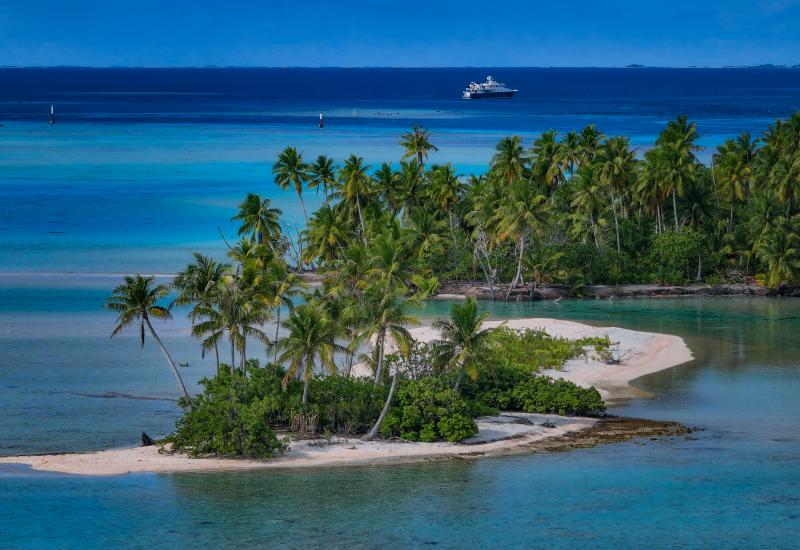St. Vincent and The Grenadines

Like many island nations, the Grenadines — Bequia, Canouan, Mayreau, Mustique, Tobago Cays, Union Island, Palm Island — and their head maiden, St. Vincent, rose from the molten gurglings of the earth. From the air, La Soufrière, the island's still-active 4,000-foot volcano (she last erupted in 1979), towers over the north coast, her rainforest-like flanks washed by daily tropical showers. The warm sands of St. Vincent, known to contain medicinal properties, are pepper-black as a result.
An aerial view of catamarans moored on the turquoise shallows inside the Tobago Cays inner lagoon is a confirmation: yachties and bareboaters (sailors eloping for weeks at a time without a paid crew) have long known these islands. They have been a secret, word-of-mouth destination, however, among the scuba world, a place talked of usually among underwater photographers with a penchant for small critter portraits.
St. Vincent has long been pigeonholed as the "muck-diving capital of the Caribbean" but that is something of a misnomer, bringing to mind sites off Mabul or Sulawesi, islands with small reef creatures but silt-riddled waters. Along sloping walls on the St. Vincent's leeward shore, the visibility can top 100 feet thanks to the density of volcanic, granite-based sand that falls quickly when stirred.
But rest assured that no divemaster leaves the boat without a pointer tucked in or strapped to his BC to indicate the fingernail-size crabs, blennies and shrimp that a less observant diver would casually miss. Diving in St. Vincent requires a vigilant eye for the reward of seeing the uncommon and minute.
The boat ride to Anchor Reef on the lee coast bypasses Kingstown, capital of St. Vincent and home to a quarter of the island's population of 120,000. Floating past several inlets marked by clustered wooden shanties and palm-lined hillsides, the striated rocks of the jagged coast are coal-colored and seem to invite cliff diving.
Nestled in a jungly bay, Anchor Reef is one of only a few dive sites that are more than the usual 15-minute jaunt up the coast from Kingstown. Once below water, it is immediately obvious why this lush alcove is a favorite dive site. No matter how many you've seen before, longlure frogfish and longsnout seahorses are a prized sighting on any dive, typically camouflaged and visible only to the keen-eyed. Dives at Anchor Reef yield three frogfish in various shades, two longsnout seahorses, a porcelain two-spot octopus and two goldentail morays.
New Guinea Reef's cliffside walls, a continuation of the vertical slant from the lush slopes above, are long columnar underhangs encrusted in sponges and draped in bottle brush and scraggly black corals. The terraced slope dropping from the inner bay starts at 30 feet and falls in measured degrees to 150 feet, the bottom thick with branching vase sponges.
A favorite spot for night diving, Orca Point gets its name from the company that manufactured the first dive computer, the Edge. At the point a rock-strewn pinnacle juts from the water's surface inside a verdant grotto-like black sand bay. Under water, the spire reveals scattered boulders, like Druid stones overgrown with vibrant encrusting sponge. There is no shortage of macro subjects disguised among the bedrock: invisible shrimp, squat anemone shrimp and sunspot anemone shrimp, neck crabs, blackhead blennies, decorator crabs, three-spotted scorpionfish, and sharptail eels.
In the shadow of Fort Durvernette, a promontory of the eastern edge of Young Island, a private tropical cay 600 feet off Villa Beach, is St. Vincent's token muck dive, Critter Corner. There is an abundance of long-spined sea urchins, tell-tale indicators of a healthy reef system. The seagrass bed at 35 feet is a favored hangout of flying gurnards, yellowhead jawfish, nimble spray crabs, snake eels, fanworms, razorfish and the rare red-banded lobster.
Nine miles south of St. Vincent, Bequia, with its rich nautical heritage, is a popular anchorage and resupply point for sailboats. Most of the dives are drifts along the leeward shoulder of the north coast and south along the volcanic walls of West Cay and Pigeon Island. Currents moving through Bequia Channel in the north provide the best conditions for sighting pelagics like jacks, sharks and rays, all drawn to the nutrient-rich waters.
Bequia's main town Port Elizabeth rises up into the hills along the beach of Admiralty Bay. Dive sites along the outer edges of this bight like Boulders, Moon Hole and Devil's Table are done as mini-drifts. Hollow boulders and fissured rocks, covered in azure vase sponges, encrusting star sponges, and finger sponges serve as ideal reef fish habitat. Varieties of moray eels, schools of snapper and filefish are common in these calmer, shallower waters.
Rimmed by a horseshoe barrier reef, the Tobago Cays and Mayreau Island are the crown jewels of the Grenadines, protected as a marine park by the government. This cluster of oases with sugar sand and shallow mirror-blue waters is a tropical nursery for juvenile fish and considered to be among the best snorkeling locales in the Caribbean.
Incoming workboats with sails that seem borrowed from the Orient tack on trade winds into the calm lagoon. Spending a day moored here off Jamesby Island among the bareboats, snorkeling lazily among patches of hard corals as the incoming tide pounds the outer reef, is restorative and intoxicating, even without the rum punch. With good reason, Vincentians speak of the curative effects of spending a day soaking up the hypnotic beauty of the Tobago Cays.
Weather: Temperatures range between 70 and 90 degrees.
Average Water Temp: Water temperatures range from 77 degrees in winter to 83 degrees in summer.
Average Visibility: Visibility varies from 25 to 150 feet.
Travel Savvy: A valid passport is required.
PARTNERS Caradonna Dive Adventures










